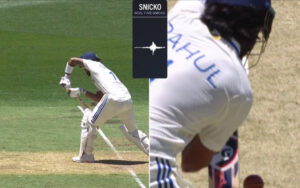
By Subhayan Chakraborty from Adelaide
Day 2 of the Adelaide Test between Australia and India was marked not only by the on-field battle but also by controversy surrounding TV umpire Richard Kettleborough and the use of Snickometer (Snicko) technology. While Australia made strides toward levelling the series at 1-1 with a strong batting and bowling performance, the day’s discussions were dominated by contentious umpiring decisions, particularly involving Mitchell Marsh.
The Marsh Incident
The first controversy unfolded in Australia’s first innings just before Tea when Ravichandran Ashwin appealed for an LBW after the ball struck Marsh’s pad, seemingly before hitting the bat. Indian captain Rohit Sharma opted for a review. Replays suggested the ball hit the pad first and then the inside edge of the bat. However, third umpire Kettleborough concluded there was “no conclusive evidence” to determine whether it was bat or pad first, citing Snicko evidence without utilising ball-tracking technology.
This decision sparked visible frustration among the Indian team, with Virat Kohli confronting on-field umpire Richard Illingworth. Kohli referenced a similar situation involving KL Rahul during the Perth Test, where Snicko showed two spikes — one from the bat and another from the pad — and the third umpire overturned the decision. Kohli pointed out the inconsistency in Marsh’s case, while commentators also questioned why ball-tracking wasn’t used, which could have shown the ball hitting middle stump and likely resulted in an “out” decision.
Rahul’s Recall in Perth
The KL Rahul incident in Perth mirrored the ambiguity seen in Adelaide. Rahul was given out caught behind off Mitchell Starc, with Snicko showing a spike but lacking clear evidence of whether the noise was from the bat or pad. The third umpire deemed the spike sufficient to overturn the on-field not-out decision, a move that drew criticism for its lack of conclusive evidence.
For the Latest Sports News: Click Here

Marsh’s Second Dismissal
Later on Day 2, Marsh was at the centre of attention again, this time for his dismissal. Facing Ashwin, Marsh appeared to miss the ball entirely but began walking off, seemingly conceding to what he thought was a nick. Umpire Illingworth, interpreting Marsh’s walk as an admission of being out, raised his finger without much appeal from India. Replays, however, showed no contact between bat and ball and no spike on Snicko, leading to confusion among players and viewers. The lack of an immediate appeal from Ashwin or Pant added to the intrigue. Marnus Labuschagne, speaking during the innings break, admitted that the Australian dressing room was equally baffled by the sequence of events.
Australia Dominate Despite Controversy
Amid these controversial moments, Australia asserted their dominance with Travis Head scoring a brisk century, driving his team into a commanding position. The Australian bowlers then capitalized on this lead, reducing India to 128/5 by the end of the day. Key wickets — Yashasvi Jaiswal, KL Rahul, Shubman Gill, Virat Kohli, and Rohit Sharma — fell quickly as Scott Boland, Pat Cummins, and Mitchell Starc made significant inroads into India’s batting lineup, exposing their lack of experience against the pink ball.
The decisions involving Kettleborough and the application of Snicko technology during the Adelaide Test have ignited debates about the need for consistent application of technology and clearer protocols for umpires. In high-stakes matches, every decision can significantly impact the game’s outcome, leaving fans and pundits calling for more transparency and precision.
Also Read: Rohit’s lack of runs and Gill squandering another start underpin disappointing Indian batting




